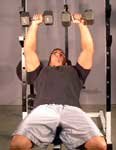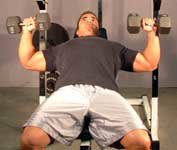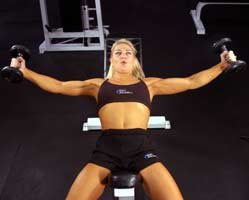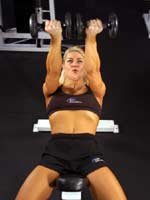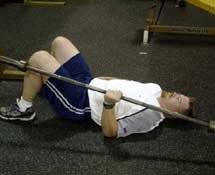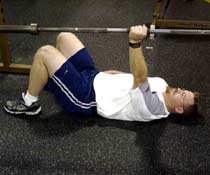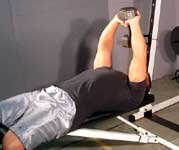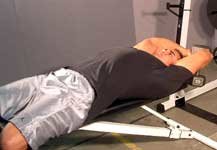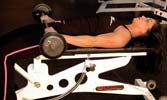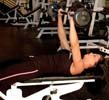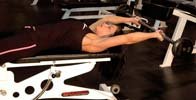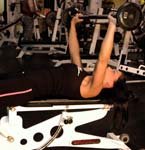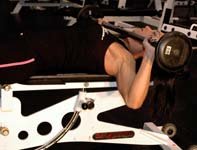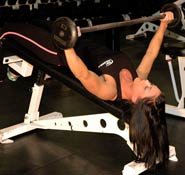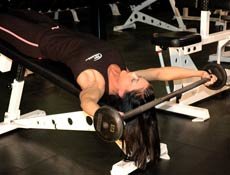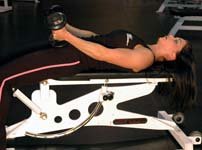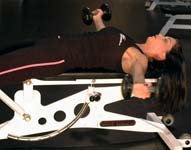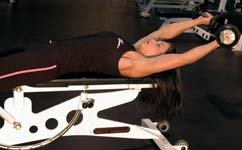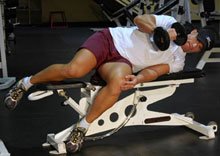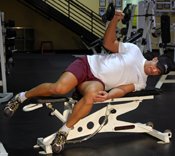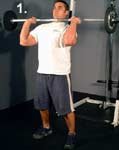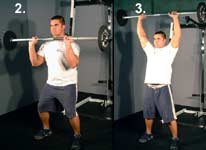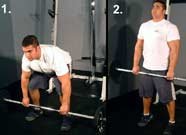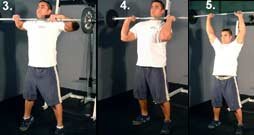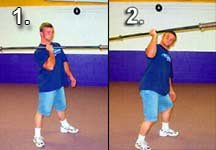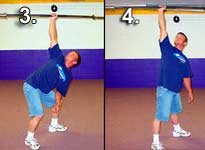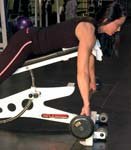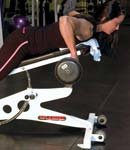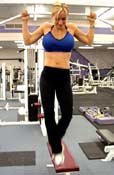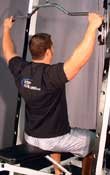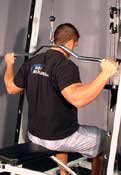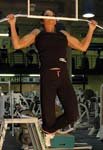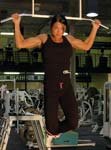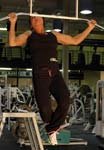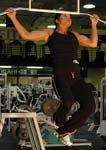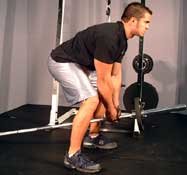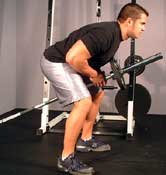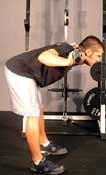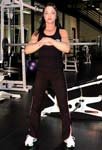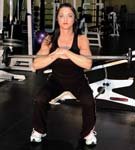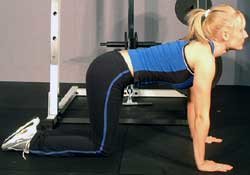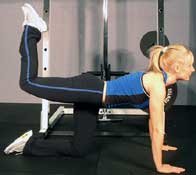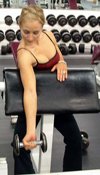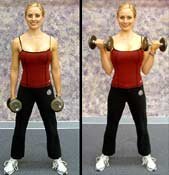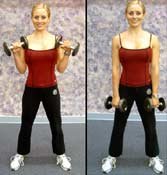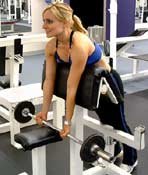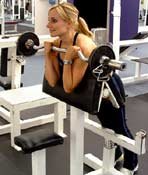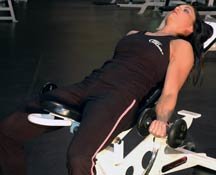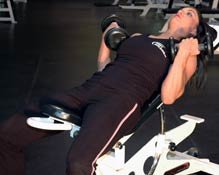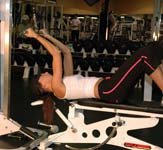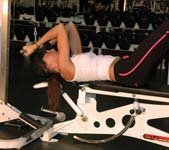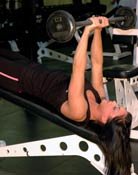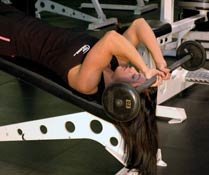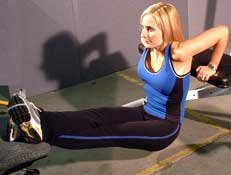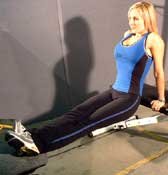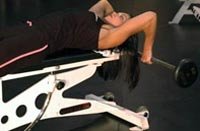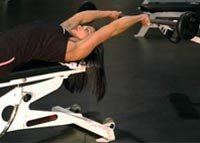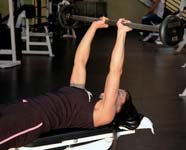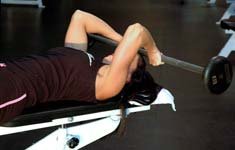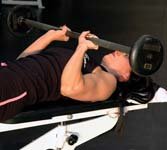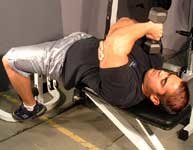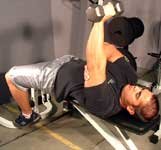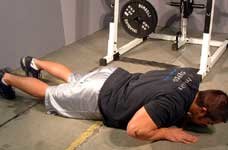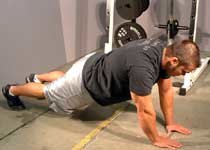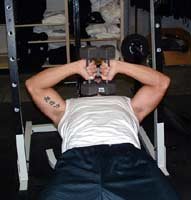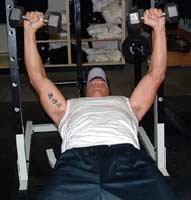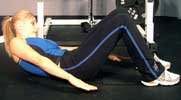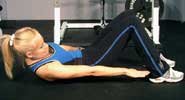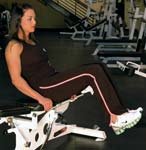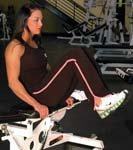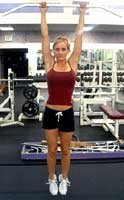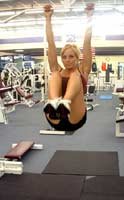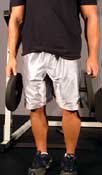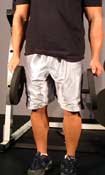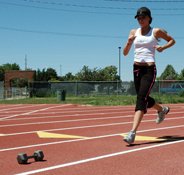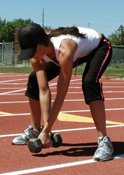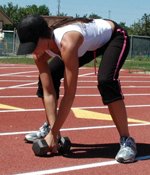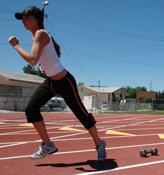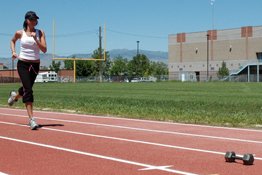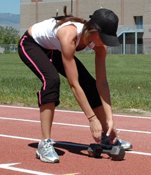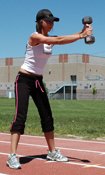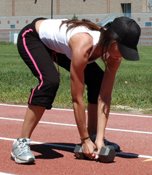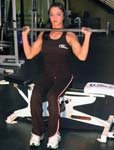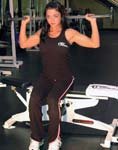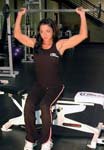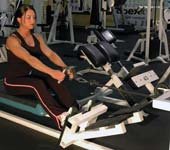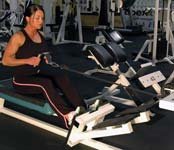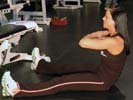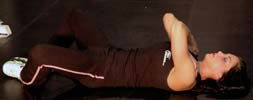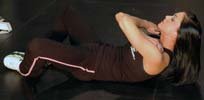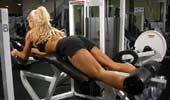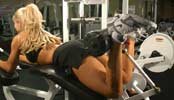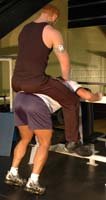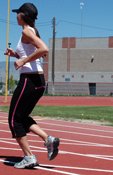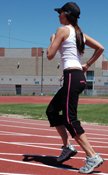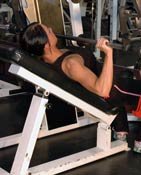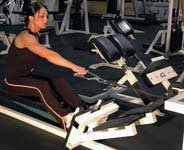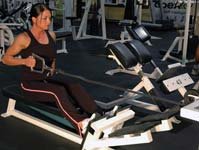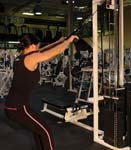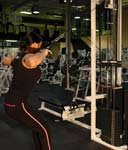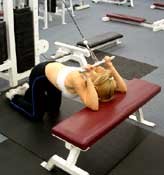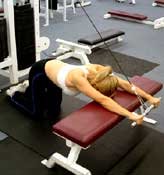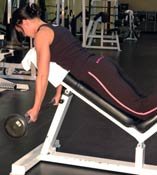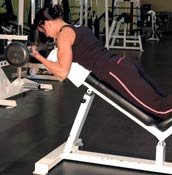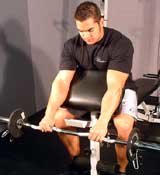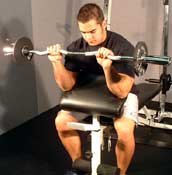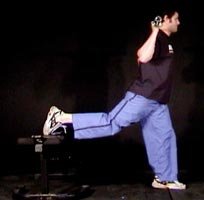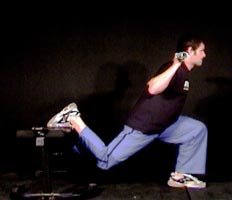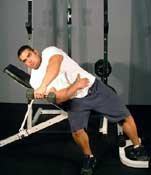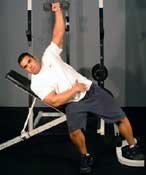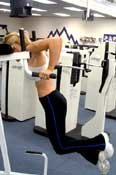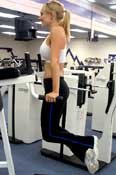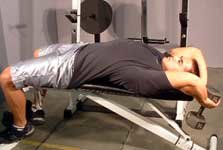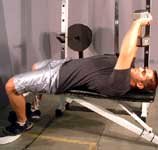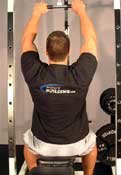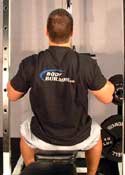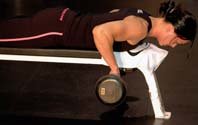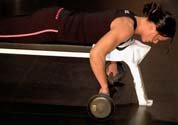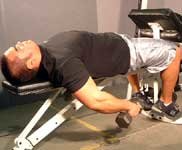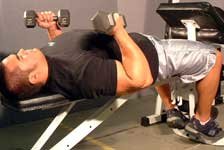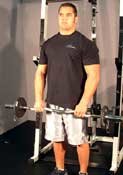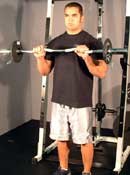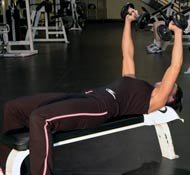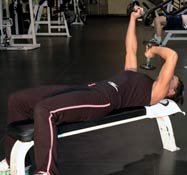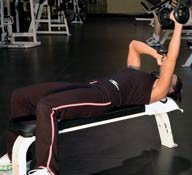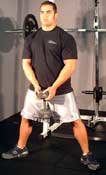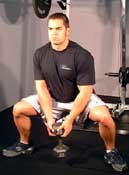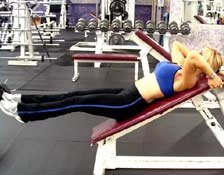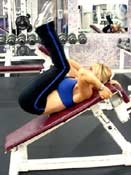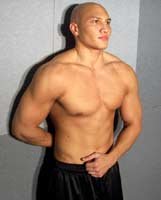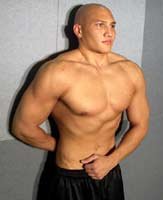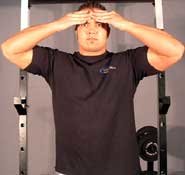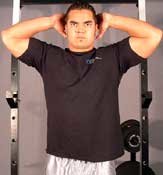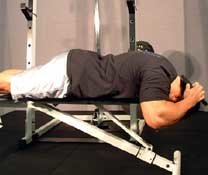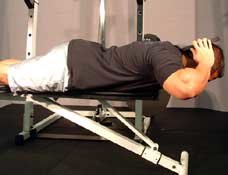
TOPIC: What Are The Best Underground Exercises?

The Question:
We all know of the squat, bench press, deadlift, bicep curl, etc., but there is more out there than just that. There are some very strange, weird, awkward, and effective exercises that aren't commercialized.
What are some of the best underground exercises? Be specific when describing them.
Which is your favorite?
Why do you think these exercises are so unpopular?
Bonus Question: Do you know of any underground cardiovascular exercises? If so, what?
Show off your knowledge to the world!
The Winners:
- 1. RippedJordanian
- 2. lc5315
- 3. Aussie LTD
- 3. misswhitney
Prizes:
- 1st place - 75 in store credit.
- 2nd place - 50 in store credit.
- 3rd place - 25 in store credit.

1st Place - RippedJordanian
Contact This Author Here. 
We all know how to do a bench press or a bicep curl, but some exercises are hidden from the general public's eye. Underground exercises can be very beneficial, as they provide a new and shocking workout to your body, which will help you put on more muscle mass.
Most underground exercises are a variation in basic movements and not completely new movements as many might think. They usually have a small trick in them which helps one concentrate the stress on a specific body part or adapt to his liking.

Exercises:
What are some of the best underground exercises?
 Chest:
Chest:
The chest is arguably the most appealing muscle in the male body, second only to maybe the biceps. A large chest communicates masculinity and strength. It is because of this, that, since the dawn of time, men have always wanted a chest that enters a room a good 2 seconds before they do.
The chest contains a higher percentage of type II (white) muscle fibers. These fibers have a fast speed of contraction, a high strength capacity, and a high capacity for anaerobic glycolysis. In other words, they are strong and get a pump easily! No wonder most bodybuilders agree that the chest is their favorite muscle to train!
Incline Dumbbell Press:
This may not sound like an underground exercise, but the way you perform it is everything so stick with me. Start in the starting position of the dumbbell press, but twist your pinky out so that they are farther back than the thumbs which should force the elbows to move out slightly.
This will remove the extra stress on the shoulders that is caused by incline movements and concentrate it on the chest. Now do the normal incline dumbbell press movement by raising your arms. Do not reach full triceps lockout at the top of the movement, which takes the stress off your chest. Instead, go up 3/4 of the movement and start going down against slowly, all while keeping the pinky behind the thumb as much as you can.
Incline Dumbbell Flyes With A Twist:
Hitting your muscles at new angles every month or so is vital for a constant increase of muscle mass. This exercise is relatively simple, but the twist makes all the difference in the angle that you are hitting your pecs. Star the exercise as you would a chest dumbbell fly, with your dumbbells vertical and parallel facing towards you.
As you carry out the movement; twist your hands slowly so that your palms are facing towards you by the end of the movement. As with the previous exercise, do not reach the top of the movement where you feel the stress is not on your chest anymore.
One-Arm Floor Presses Dumbbell/Barbell:
This exercise is effective because it allows you to work through the full range of motion of the chest, which you cannot do with barbell bench presses and even dumbbell ones. Lie on a bench and grab a dumbbell or barbell in one arm only. Now begin the pressing movement as normal.
Use your other arm to spot yourself or to steady yourself on the ground. As you reach the top of the movement, turn your body into the hand that is pressing by pushing with the other hand and contract your chest. This will help get a maximum pump and contraction.
Straight-Arm Dumbbell Pull-over:
This is a great exercise to isolate the chest. Do a normal dumbbell pullover on a bench, but keep your arms extended so that your elbows do not bend. Pull the dumbbell just over your head and do not continue past that point as you start to incorporate too much lateral muscles. Now, while keeping your arms extended, lower the dumbbell to the point just above the ground and contract your chest.
Front Raise and Pull-over:
This is a mixture of the barbell pullover and a front raise on bench. Lie on a flat bench and grab a barbell using a grip about 15 inches apart, Place the bar on your upper thighs and lock your arms. Now raise the weight over your head. This is the first part of the exercise.
Now continue the same movement behind your head as far back as possible like the reverse of a pullover. Now return the dumbbell to the starting position again in the same motion.
Neck Press:
This is the same as a normal flat bench press, except you bench to the neck instead of to the chest. You start and finish the pressing motion from the neck.
Wide-Grip Decline Barbell Pull-over:
As I stated before, hitting the muscle from a different angle is invaluable for muscle growth. As a result, this exercise causes your chest to work through a different range of motion. Use a Barbell instead of a dumbbell for a pullover, and do the exercise on a decline bench. Also, use an extra wide grip on the barbell.
As you raise the barbell over your head, try to squeeze the bar as if you are pushing the ends together, because this helps get a maximum contraction.
Around The Worlds:
Grab two dumbbells and sit on a bench. Now put the dumbbells face up towards the ceiling on your upper thighs while keeping your elbows slightly bent. Now move the barbells, not up, but around as if you are drawing an angel in the snow. Bring them behind your head so that they touch each other and return to the original position. This movement is great for getting a pump in the chest.
 Shoulders/Traps:
Shoulders/Traps:
The shoulders are vital for that bodybuilder masculine V shape that the shoulders provide. Without that shape, all else fails to impress. Wide shoulders also mean don't mess. Wide shoulders also make your waist appear slimmer, further enhancing your package.
The deltoids, unlike the chest, are a small muscle group made of slow twitch red muscle fibers. That means they respond to higher reps, partial movements, static holds, and slow movement. Unfortunately, except for those with good genetics, it means muscle size is limited.
Nonetheless, especially with shoulders, a small increase in mass is extremely obvious and gives you a great look of masculinity as well as making the waist look slimmer. Here's a great introduction to the shoulder muscle: Click.
External Rotations:
This exercise does not build as much mass, but it helps protect your shoulders from injury but training your elbow muscles which rotate your arm. It is quite difficult to explain, so I'll let you read the description.
Handstand Push-up:
It is the greatest shoulder builder of all time, and the exercise which almost all bodybuilder's fail to do. Do you know that less than 20% of professional bodybuilders can do a handstand pushup? Obviously neglected, but extremely effective, this exercise allows your body to move around the weight, which is better for muscle building.
Put you hands on the ground and push your legs up against a wall so that you are leaning against it with your hands on the ground. Adjust your hands accordingly so that you do not have a chance of falling down while doing the movement. Now lower yourself slowly as if you were doing a shoulder press. Do not let your head touch the ground to keep the stress on your shoulders. Now push back up.
Arnold Presses:
These are normal dumbbell shoulder presses, but with a twist. You start with the palms facing towards you, and raise them above your head while twisting them. Your palms should face forwards away from you, at the top of the movement.
Push Press:
A movement which is similar to the power clean, it can be described as a standing military press. Begin with the barbell in front of your head resting on your shoulders as close as possible. Your elbows should be forward. Now push the barbell forward while lowering your elbows. Then press the barbell above your head.
Clean and Press:
An extremely difficult to explain exercise, better you read the source.
Bent Press:
Stand with a barbell or dumbbell in one hand. Your hand should be between out to the side and in front of you, as if you are at the top of a barbell curl. Now lower your head slightly and twist the barbell or dumbbell as you raise it above your head. At the top of the movement, your palms should be facing away from you and the barbell should be in the air.
 Back:
Back:
The back is one of the most neglected muscles in the body. However, it does contribute tremendously to the V-shape of the upper body with the shoulders. A wide, thick back conveys masculinity and strength, and believe it or not, the back is one of the main muscles that give you that massive bodybuilder look along with the chest.
Almost all Mr. Olympians, such as Ronnie Coleman, Dorian Yates, and Arnold Schwarzenegger, have amazing backs. As a result, it's important to work this muscle. And if you want wide thick back muscles, its imperative that you work the muscles using exclusively compound exercises, because isolating the back is ineffective and against nature. A stronger, bigger back also improves neck/upper body posture.
Gorilla Chin-Up:
This is a great exercise which incorporates the abs, as well as hits the lats from a new angle. Hang from a chin-up bar, and raise your legs to the level of your face while doing a chin-up. The result will be more effective because it's a compound exercise involving the back, abs, and biceps.
Incline Bench Pull:
This exercise focuses on the middle and outer part of the back. Lie face DOWN on a bench and place a weighted barbell at the level of your head. Place a block of wood under the front part of the bench where your head is to elevate it and hit your back from a different angle. Now grab it and pull it up as if you are doing a reverse bench press. Remember to look up and keep your back flexed.
Wide-Grip Rear Pull-up:
This is the exact opposite of a behind the neck military press for shoulders. Assume a wide grip with your palms pointed away from you, now do a normal pull-up. However, as you reach the top place your neck in front of the bar instead of behind it with the rest of your body. If this puts too much pressure on the joints or if it hurts and causes lasting pains, assume a narrower grip or do not do this exercise at all.
This exercise should not be done excessively as it puts too much stress on the bones. I would not suggest weighted versions of this exercise either. 2 or 3 sets are enough per week.
Wide-Grip Lateral Pull-downs Behind-The-Neck:
This exercise is the same idea as the pull-ups, but with the lateral pull-down machine. Again, this awkward position will place the joints in a vulnerable position. Try to keep the amount of sets you do this to a minimum, with higher rep ranges between 10-12.
Rocky Pull-ups/Pull-downs:
Simple, pull-ups to the front followed by pull-ups to the back.
Side-To-Side Chins:
A simple wide grip pull-up, however, you lean to one side every rep. This places more stress on each side of the back to create astounding growth!
Mixed-Grip Chin:
Simple, one hand with palms facing forward and the other with palms facing towards you. Do 4 sets, and change the hands for each set. This ensures your back is fully worked while putting extra stress on a side depending on the hand placement.
One-Armed Chin-Up:
The most difficult variation, but also the most mass building one. The form is that of a wide grip pull-up, however, the other hand will be helping with only balance. This is ensured by placing a towel around the bar and holding on to the towel with the other hand. This builds fore-arm strength in one hand and a wide powerful back in the other. Switch sides to ensure an even muscle build.
Bent-Over Long Bar Row:
This is the exercise Ronnie Coleman is famous for, which says a lot about the results it will get you. Stand in the form of a barbell row, but instead, put a barbell between your legs and raise it. This exercise will work your middle back.
Good Mornings:
Although they take a lot of skill, balance, and co-ordination to master, good mornings can be a great addition to your lower back workout. Start with the bar on your back as if getting ready for a squat. Bend down slowly as if you want to pick something up. DO NOT try this the first time with weights as there's a big chance you can fall and break your jaw. Once you get the hang of this exercise, it will definitely help.
 Legs:
Legs:
The legs are surely the muscle that differentiates the bodybuilder from the average gym rat. It's so easy to forget about these muscles because they are rarely ever seen. However, it's imperative that they are trained to support all the muscle mass which you are adding in your upper body. Also, tree trunk legs convey amazing masculinity and power. As a result, legs should not be forgotten about.
Sissy Squats:
Contrary to their name, they are not at all an easy exercise. Sissy squats are a great way to start off your program to get a good stretch and a muscle building workout at the same time. Hold something for support, and proceed to bend your knees and raise up on your toes while bending your buttocks to the floor. Hold the stance for a moment before standing back up.
Jefferson Squats:
These are a rare and unparalleled exercise for building your inner thighs. It is a normal squat, but while holding the weight between your legs. It does sound and feel awkward, but the results make it worth it.
Zercher Squats:
Another rare variation of the squat to build upper quadriceps mass. Do a squat, but hold the weight in front of you in your arms as if you are holding a baby.
Glute Kick-back:
This is a great butt builder and will make it more muscular and firmer. Lie down with all fours on the ground in a crawling position. Now raise one leg and pull it back and up as far as you can. Concentrate on moving solely the glutes.
 Biceps:
Biceps:
There is no question on the importance and popularity of the biceps! What's the first thing you do when someone asks you to flex? You flex your bicep, not your quads! What's your favorite muscle to train at the gym? Biceps! These are probably the most over trained muscles in the human body, but also them most improperly trained.
Zottman Preacher Curl:
This is a one armed, dumbbell preacher curl on the preacher stand. As you curl the bicep, focus on pressing and contracting the muscle, and as you raise your arm, twist it so that the palms are facing forwards by the end of the movement. This curl is great for an even working of both the inner and outer branchii of the muscle.
Zottman Curl:
This is basically a standing dumbbell curl, but with the same twisting idea of the Zottman preacher curl. Stand with 2 dumbbells, and curl each one. As you reach the top of the movement, twist so that the palms are facing in front of you.
Spider Curl:
The spider curl is probably the most underrated bicep exercise. It's even more effective at isolating the biceps than the standing barbell curl, because it prevents the back from working by forcing one to lean against the stand. This also leads to its lack of popularity because one cannot use as much weight with it as the standing barbell curl.
Flexor Incline Dumbbell Curls:
These are designed to keep the stress completely on the bicep. Hold the dumbbell towards the side farther from you so that you have more weight on the side closest to you. (This can be done for a good effect on all bicep dumbbell exercises). Now do a normal incline dumbbell curl, but keep your wrists as far back as possible so as to neutralize any stress that is placed on them. This is extremely effective at isolating the biceps.
Drag Curl:
Just the same as a standing barbell curl, but you must keep the barbell about one inch away from your chest/torso the whole time. That means your elbows bend back as you raise the barbell up. It can be done with both kinds of grips for a muscle shocking effect!
High Cable Curls:
It's great to be able to hit the muscle from more than one angle using different positions; this encourages quick shock growth from the muscle. In this exercise, lie on a bench under one of the cables and set it on the highest. Now hold the cable and curl your hand. This also can be done with both grips.
Arnold 21's:
This is the exercise which grew Arnold's legendary biceps. Grab a barbell and perform a normal curl, but when you reach to the halfway point where your arms are pointing straight forward, go back down. Do that for 7 repetitions. Now curl the weight all the way up, but lower down only to the halfway point. Do this for another 7 repetitions. Now do 7 normal full repetitions without taking a break. The hardcore pain is extremely difficult to cope, but, as you know too well, no pain=no gain.
 Triceps:
Triceps:
Many people work their biceps to death in hopes of getting a larger arm. But they don't realize that it's the triceps that make up 2/3 of the arm. Anyone hoping to get larger arms should train this muscle well! These muscles, in my opinion, should be given even more attention than the biceps, because your biceps don't fill the shirt sleeves!
Decline Close-Grip Bench + Skull-Crusher:
The ULTIMATE triceps exercise. It combines the explosive power of the close grip bench press with the unmatched stretch and concentration when doing skull crushers. Form is extremely important, stress on the eccentric (lowering) portion of the movement and contract at the top of the movement.
Start with a bench press from the lower chest, then as you lockout, contract and begin lowering for the eccentric portion of the skull crusher. Now raise the barbell again and do the eccentric portion of the bench.
Dips Behind Back:
It's a variation of the dip with the hands behind the back for isolation of the triceps. It's important to have slow eccentrics and concentrate, as well as adding plates on the legs if you need more resistance. Quite simple, find 2 high benches and put your legs on one end and your hands on the other.
Old School Reverse Extensions:
It's a great angle to hit the triceps hard and induce muscle growth, lie down on a bench and grab a barbell with an underhand grip. Keep your upper arms in a straight line with your body as opposed to perpendicular as in skull crushers. Lower and raise the weight.
JM Press:
A great exercise to work all 3 heads of the triceps, it's a mix of the close grip bench press and skull crushers, but at the same time, and starting from the lower chest. Use the underhand grip also.
One-Arm Triceps Extension:
This is an effective variation of the normal exercise; lie down on a bench with a barbell. Put your elbows up, perpendicular to your body. Now lower and lift the weight with your other hand spotting the working one.
Close-Grip Push-up:
An amazing exercise if you can't get to the gym, it's a normal push-up stance, but with your hands close together. It puts all the stress on the triceps, and is much harder than it looks.
Tate Press:
This is the same as the one armed triceps extension, but with both arms. It's an unconventional and result-producing exercise which effectively isolates the triceps.
 Abs:
Abs:
Now talk about abs, one of the most chick producing and sexy muscles, but extremely un-satisfying to train. They also won't show unless you burn fat. That's why it's important to make them as big as possible during your bulking phase so they can show easily when you cut.
The abs is more of a stabilizing muscle than a moving muscle, and many people forget that when training them. That means static compressions and holds are much more effective than moving exercises. Here's a good guide to the anatomy of abs: Click.
Alternate Heel Shoulders:
Lie down on the floor, with your knees raised. Extend your arms fully on the ground and raise your head slightly so that your abs contract. Now hold this position while you alternate touching your heels with each hand. Here's a guide to better explain it.
Another variation which is even more effective is lying in the same position. Again, now raise up your head to contract your abs and sit up a little. Now touch your knees and hold on, and raise your arms slowly above your head. This is an extremely hard exercise to perform and to keep your balance.
The lower you keep your knees, the harder it is, so as you improve, you can lower your knees more. Your abs should stay contracted, and should be subject to more stress as you raise your hands. This trains the abs the way nature intended, which should produce astonishing results. This exercise will really burn your abs.
Seated Leg Tucks:
This is a great exercise for overall abs exercise. Sit across a bench and extend your legs so that your abs are contracted. Now slowly bring your legs to your torso/ribcage and return them to their original position.
Hanging Reverse Crunches:
Hang with a wide grip on the chin-up bar. Now raise your legs as high as you can so that they rise above your shoulders. This is a great compound exercise for abs, which is what produces the most results. It's important to raise your legs slowly and feel the burn.
 Forearms:
Forearms:
Forearms should be given just as much effort as all other muscles, if not more. They are the most useful muscles in your everyday life. A strong grip in your daily activities is invaluable. The forearms are also fundamental in almost all back and bicep exercises.
Wrist Roller:
Another great exercise for overall forearm development, you will really feel the burn after doing this. Grab a plate and tie a strong string to it on one end, and a round cylinder object on the other. Now extend your arms and roll your wrists as if you are rolling a newspaper.
Plate Hand Squeeze:
This is a great exercise for functional grip. Just grab a plate and place it at the tips of your fingers, then squeeze up and down slowly. This will really get the pump going!
 My Favorite Exercises:
My Favorite Exercises:
Incline Dumbbell Press:
I really love this exercise; the small twist makes all the difference in pumping up your chest to the fullest, and resulting in massive gains! Form and concentration is the most important part of this exercise, as well as keeping your elbows out.
It also helps to only go up 3/4s of the way, so as to keep the stress on your chest. After implementing these minor changes in my chest dumbbell work, my lifts and mass increased dramatically, and I even started getting compliments!
One-Armed Chin-Up:
I personally love this exercise; because it puts so much stress on the back and helps you concentrate on one side of your back. You also probably don' need to use a weight belt, and the concentrated stress you get on your back is unmatchable by any other exercise! This is a great exercise to try as it also gets your forearms in you other hand pumped up as well. This really helped me get the back strength I lacked.

Unpopular:
Why do you think these exercises are so unpopular?
These exercises are great at shocking your muscles into new unmatched growth, so it's very odd that they are not very well known. However, the problem usually is that these exercises are covered up by the more marketable and "cool" exercises found in the muscle magazines.
Bodybuilding is a business, and what is more marketable and attractive in magazines is preferred over what will actually bring results. Also, if you knew the most effective exercises for gaining muscle; you wouldn't be a customer for too long would you?
This article, however, is aimed at showing you what the most effective exercises are for gaining muscle and shocking your body into a growth spurt. The problem is also, that these exercises are usually created by one specific bodybuilder. They aren't very well known as the bodybuilder doesn't put them into magazines.
The reason for this is that they are his secret to gaining muscles, and he doesn't want to share them with the rest of the world. As a result, these effective exercises are not known by anyone!

Bonus Question:
Do you know any underground cardiovascular exercises?
 High Octane Cardio/Roadwork:
High Octane Cardio/Roadwork:
HOC is an incredibly tough and excruciatingly painful cardiovascular exercise where you push yourself to the limits. Boxers nickname it "roadwork" and it has been used by all serious athletes as a way to fitness and fat loss. It may be painful, but the reward is worth the pain, melting the fat off like a blowtorch!
The principal of HOC is combining an aerobic exercise with an anaerobic ballistic exercise to melt off the fat. Aerobic exercises include jogging, dancing, and boxing. Anaerobic ballistic exercises include dumbbell swings, snatches, or clean and jerks. Mixing any 2 of these will be effective.
A good beginner's workout would be to place 2 dumbbells at 1/4 mile intervals [(One lap on a regulation size track)]. Start out at the first dumbbell and do a 1/4 mile jog to the next one. Without rest, grab the dumbbell and perform some dumbbell swings.
You have performed 1 lap. Jog back to the first dumbbell and do a set of dumbbell snatches. You should be able to perform at least 4 laps without rest. Keep exchanging the exercises.
For example, you could jump rope or box for a specific amount of time, then perform a ballistic exercise. Another ballistic exercise you could try is the clean and jerk. As you advance, increase the laps you perform, the weight you use, the speed you run, and the distance you run. This will increase intensity and keep the fat burning!
Performing these exercises will surely give your muscles a new shock to quickly gain more mass and burn more fat. These exercises, however, should not be used too long as they will loose their shock effect and will become just like the normal exercises you do each day. Have fun with these variations, and I hope you reach your goals with this knowledge!
If you have any questions, message me on the boards at rippedjordanian, or e-mail me at Dark_knight_Basil@hotmail.com.
Thanks, Basil

2nd Place - lc5315
What Are The Best Underground Exercises?
Contact This Author Here. 
We all know of the squat, bench press, deadlift, bicep curl, etc., but there is more out there than just that. There are some very strange, weird, awkward, and effective exercises that aren't commercialized.
'Underground' exercises. Doesn't it bring about a whiff of secrecy, a cloak of mystery which surrounds these unknown entities so called 'underground' exercises? Why are they categorized so? It may be because they are downright tough, for the hardcore only.
They may be exercises that leave you in your own sweat and tears with a bucket of puke on the side? Hearsay you may think? Let us take a cautious walk to find out more. WARNING: NOT FOR THE FAINT HEARTED!!

Exercises:
What are some of the best underground exercises? Be specific when describing them.
Before I go on to describe these exercises, one must take note that these are NOT 'MAGIC' exercises and that doing them would brink up a particular body part to gigantic proportions. A sensible diet, training plan and sufficient sleep are some of the components to a bigger, leaner body.
What these exercises do provide is variety and a possibility of you finding the way, the right mind-muscle connection, to understand the muscle and how it's being worked.
 Shoulders:
Shoulders:
Bradford/Rocky Presses:
Start of the exercise like a military press. Press the barbell to arm's length overhead. Then lower it behind your head to your ears. Press the barbell back to arm's length overhead and lower it to the front. Think of it as alternating between a front press and a behind the neck press. Inhale as you are pressing and exhale as you are lowering the weight. Front and back should be considered one repetition.
A little tip for making this a more challenging is to push/raise the bar till a height where it is JUST high enough to clear your head and move it to the back. By not locking out the weight, you're putting the stress on your shoulders and keeping it off your triceps and this provides continuous tension for your delts.
 Triceps:
Triceps:
Tate Press:
Start this exercise with a pair of dumbbells in the top/finishing position of a flat/low incline dumbbell press. From there, lower the weight, like you would in a tricep extension, until an inch or so from your chest. Extend the weight back up to complete the rep.
A point to note, try and keep both dumbbells in contact with each other throughout the rep. This will help you keep the movement controlled and focus on working the triceps.
JM Press:
Start in the bench press position but with a grip that is used is a close to medium grip (thumb distance from the smooth part of the bar). Keep your elbows tucked in to minimize shoulder involvement/rotation and lower the bar in a straight line to an inch or 2 above your neck. Press/extend it back up to complete a rep.
 Biceps:
Biceps:
Drag Curls:
In a nutshell, this is a barbell curl where the bar stays in touch with the body, dragging it along the torso throughout the rep, thus its name. It helps you learn to keep your elbows back and places more stress on the biceps when lifting the weight.
Zottman Curls:
Perform this exercise standing or seated. The Zottman curl is a curl with a normal dumbbell curl concentric portion (palms up) and a reverse dumbbell curl eccentric (palms down). It is best done in an alternate fashion where if you start with the right hand and curl it up to your right shoulder, start curling your left arm at the same time you lower your right arm.
Gironda Sternum Chins:
Many have dubbed this the single best lat exercise ever invented! This involves leaning back throughout the entire movement. In this variation, the lower portion of the chest should touch the bar. Begin by grasping the pull-up bar with an underhand grip, approximately shoulder width apart. Now hang with your arms fully extended.
As you pull yourself to the bar, have your head lean back as far away from the bar as possible and arch your spine throughout the movement. At the upper end of the movement, your hips and legs will be at about a 45-degree angle to the floor. You should keep pulling until your collarbone passes the bar and your lower chest or sternum area touches it. By the time you've completed the concentric portion of the movement; your head will be parallel to the floor.
Elevated Cable Rows:
Get a platform of some sort that is around 4-6" in height (calf raise platform, aerobics platform etc). Place it on the seat of the cable row machine. Lean forward with a strong arch in your back. Keep this leaned forward position while pulling into your abs. This exercise hits the lower lats hard.
 Abs:
Abs:
Eagle Sit-Ups:
Lay down on the floor in front of a power rack. Spread your feet wide, past the posts of the rack. Now, like you're doing a hip adduction exercise, bring your feet inwards to 'catch' the posts of the rack. Now, perform partial/full sit-ups.
Frog Sit-Ups:
This exercise was 'invented' by Vince Gironda. First, sit on the floor with the soles of your feet touching each other. Next, lay down on the floor and TRY and push both soles to as near the crotch as possible. Your upper thighs should optimally be very close to the floor.
Picture a diamond shape that's formed when you're in this position. Now, with your hands crossed and touching opposite shoulders or lightly touching your ears, exhale firmly through pursed lips and flatten your lower back to the floor while curling the torso upwards. (Like the first 1/4 movement of a sit up.) Hold at the top position for a two count, if you wish. Slowly lower to the floor or mat, relax the abdomen completely and then repeat.
 Quads:
Quads:
Jefferson Squats:
This is a squat variation but instead of the bar being in front, overhead or on your back, they are between your legs. You should be in a slightly wider than shoulder width stance with toes pointing slightly out. Straddle the bar at the middle of it length wise and place your right hand with an overhand grip on the rear of the bar and your left hand with an overhand grip at the front of the bar.
Squat the weight up, making sure the bar stays straight, parallel to the ground, doing so while keeping your back arched and as vertical to ground as possible. This exercise supposedly ignites growth of the inner thighs!
Gironda-Style Leg Curls:
This exercise is done on a regular lying leg curl machine. In this variation keep your torso elevated, in a pushup position. Keep that position as you curl the weight up. You will feel more stress to the upper portion of the hamstring complex (hams/glutes tie-in).
 Calves:
Calves:
Donkey Calf Raises (Arnold style):
Many of you may have seen Arnold do this in his hayday, but how many of you actually know that it was called Donkey calf raises or even do them? I'll just give you a quick run through on how to perform them. First, go to a gym with obese people. (lol, alright, I'm joking, but they do accelerate calf development while doing this exercise!)
OK, lean over on a knee height or slightly lower bench/platform, forming an 'L' shape with your torso and lower body. Have a calf raise platform or a thick Olympic weight at the bottom of your feet, tip-toeing on them. Get a few buddies to sit on your back, like they do when horse riding and start repping out some donkey calf raises!
 Which Is Your Favorite?
Which Is Your Favorite?
Thought rack deads were hardcore because of the BIG weight you're throwing around? Or how about some heavy @ss full deadlifts that leave you breathless together with a skin-tearing lower back/trap pump? Hold on tight because my favorite back 'underground' exercise, the Waterbury Walks (or deadlift walks), bring much more to the table than that.
They are a combination of the meat & potatoes exercises for the back, the deadlifts and rack deads. Together with a farmer's walk element, you'd be doing a full body workout from your thighs up to your lower back, upper back, traps and your arms. Working up to heavy weights with this would give your whole back a kick in the @ss and improve your grip by leaps and bounds.
This exercise would pack a whole lot of muscle on especially the lower back (erectors). I do it in the 2-3 set, 6-8 rep range. A good aim to shoot for is to be able to perform the exercise with a weight that is 1.5X your bodyweight. Try it and let me know how it goes!

Unpopular:
Why do you think these exercises are so unpopular?
These exercises are mainly variants of the originals, i.e. the drag curl is to the barbell curl; or the Bradford press is to the Military press. They are 'invented' by people who adjust and tweak the original exercises in a way that may suit their physique or where they can feel the targeted muscle much better.
Word of these variants, being individualized to the lifter's needs, seldom spread or get passed around as it is sort of a personal thing to the lifter. The only exception is when somebody asks about the weird or unique way in which one is performing an exercise.
Then, will these underground exercises receive attention and be tried by more lifters. (Think about it. Let's say you're a right hander who eats with a spoon in your left hand and the fork in the other, unlike how most right handers handle their cutlery. Do you go about announcing to the world or maybe to a lesser extent, bring up this topic while dining with a friend that you handle your cutlery this way? I doubt so. That's a similar logic to the one above!)
Next, is the simple fact that some of these exercises are damn hard to do! Take the Glute Ham Raise (GHR) for example. How many can execute a perfect GHR with their hands behind their back, back arched and all, on their first couple of tries? Many people can't even do it hands free after practicing for some time. Another example would be the Gironda dips or wide parallel bar dips.
These exercises are tough to execute and most people give up trying and not being able to perfect their technique over time. If you're one of those hardcore lifters out there, and I know you are, give them an honest try!

Bonus Question:
Do you know of any underground cardiovascular exercises? If so, what?
I have no idea if what I'm about to describe is known widely, but I've never seen it done before, besides by myself and people I've introduced it to. This 'underground' cardiovascular exercise is backwards running or SDRAWKCAB running if you may! Like its name suggests, instead of running forwards, with your toes 'leading' the way, you reverse it (no don't turn your body/twist your torso or anything here) and run backwards, with the heels 'leading' this time.
Running backwards puts a lot of your stress on your front thighs and before you know it, you can feel the front quads working in overdrive and feel the burn in the thighs. You can start by doing your regular morning cardio backwards, but please, look over your shoulder from time to time to make sure you aren't running onto the road or into people!
What I feel provides the best backwards running workout in the shortest time, is running backwards up a hill or an inclined slope. Find a place with a gentle incline to start off, where motorists are few and far between, and start running backwards up the hill.
You may think you're 'Joe Macho' and go pretty fast initially. Give it a minute or so and tell me if you aren't running backwards at normal walking speed! Once you've reached the top, take a slow jog down (I know how much you'd like to run down and let the momentum carry you forwards, but nope, that's against the rules of this 'game'!). When you reach the bottom, repeat. You can carry on for a period of 20-40 mins or so.
Points to take note, if you're worried about this affecting your quad workout, please do not do them on the same day. Do them on off days if possible, working up from 1-2 times a week. Another tip, I feel this is an excellent way to accelerate recovery the day after your quad workout as backwards running uphill mainly involves the concentric portion of quad involvement.
As we all know, the eccentric portion of an exercise is what causes the most stress and microtears in the muscle, thus one should not worry about 'overtraining' here. This helps draw blood into the quads to aid recovery.
HARDCORE ALERT: For those who are longing for a challenge, a kick in the butt only. Give running backwards uphill, HIIT style, a go! I've warned you!

Conclusion
There are several other 'underground' exercises out there for you to invent and try out. Keep an open mind to the world of bodybuilding. Eat well, rest well and train balls to the wall. Remember my motto, K.I.S.S. Give the above exercises a fair and honest chance watch the beef pack on!
References:
- https://www.bodybuilding.com/fun/exercises.htm
- www.trulyhuge.com
- www.abcbodybuilding.com
- www.ironbarbell.com
- www.t-nation.com
- www.davedraper.com
- Troponin

3rd Place - Aussie LTD
What Are The Best Underground Exercises?
Contact This Author Here.

We all know of the squat, bench press, deadlift, bicep curl, etc., but there is more out there than just that. There are some very strange, weird, awkward, and effective exercises that aren't commercialized. In this article I will reveal my favorite "underground" exercise and discuss a little about why they are so unpopular. Please read on.

Exercises:
What are some of the best underground exercises? Be specific when describing them.
There are a lot of exercises I have used and still use that aren't your conventional exercises. After several years of training, it comes as second nature to starting thinking more innovatively, and you begin discovering new "twitches" to current exercises, and even discovering new exercises themselves.
Although I don't claim to have created the following exercises, most of the information I have provided within each exercise are tips I've discovered myself through experience.
So here they are; my favorite "underground" exercises for every body-part.

The Mid-Section
 Chest:
Chest:
Close-Grip Smith-Machine Incline Presses:
If there is one area that most people complain about, it's the upper-inner portions of the chest. Filling in this area will fill in the gaps in the chest, as well as make it appear fuller all-round. How did I develop this area? Close-grip incline presses.
Although close-grip presses are known as a tricep exercises, I find they are great at also hitting the upper-inner chest when performed on an incline.
To do these, set the incline on your bench anywhere between 45-65 degrees and adopt a close-grip on the bar; one that isn't too close that it causes discomfort on the wrists, but too not far that it ventures into targeting the outer portion of the chest. Keep in mind that although a higher incline is more effective for this exercise, your delts and triceps will heavily come into play taking away from the chest stimulation.
As you lift the weight up, focus on squeezing the chest. Pause at the bottom of the movement to avoid the use of momentum. One thing I've found helpful with this exercise is that if you keep your elbows out rather than tucked in to your sides, it increases the tension to the chest.
Perform on a smith-machine which allows you to isolate the inner chest more.
 Back:
Back:
Seated One-arm Cable Pulley Rows:
These are a variation of the traditional seated cable row. By using a single attachment, you are able to get an incredible stretch on the lats, and additionally using one-arm allows you bring the weight in deeper and increases stress to the traps.
To perform these, sit at a seated cable row station with you back erect, feet planted firmly against the pads and your knees only slightly bent. Attach a single attachment to the bottom, and grasp it in either hand. Make sure you are far away enough that you are able to feel a stretch along the outer lats.
Bring the weight in towards that same side, keeping your back straight and your chest out. There is a really good opportunity to contract your lats, so bring the weight in all the way. It's an idea to twist your wrists from an underhand to an overhand grip, which you'll feel in your back.

The Arms
 Delts:
Delts:
Cable Rope Rear-Delt Rows:
There are many options for stimulating the front and side delts, but it seems so many people can't bring up their rear delts at the same speed. I have found an exercise called cable, rope, rear-delt rows which does.
For some reason people use bent-over laterals raises, and as they involve minimal weight, it encourages people to turn them into compound. As a result, all the tension is transferred onto the muscles of the upper back, and little rear-delt stimulation.
Then others either just rely on compounds, or use upright rows, which actually target the traps, biceps and back just as much if not more so than the rear delts. So I discovered an exercise called the rear-delt cable row that stimulate this area better.
Rear-delt rows also allow you to use a weight that is not possible on the only other isolation exercise for the rear-delt. To perform these rows, sit in the same position on a cable-row station as you would doing seated cable rows. Attach a rope to the pulley and grasp it with an overhand grip. Stretch your lats if you wish, stand upright and bring the weight in and upwards towards your neck.
The trick is to extend your forearms upwards as you pull the weight to your neck, and at the end of the movement, your arms will finish in a bicep-pose with your lower arms parallel to the floor. By doing this, it activates the rear delts and allows for a peak contraction.
 Triceps:
Triceps:
Kneeling Cable Triceps Extensions:
These are one of the best ways to carve in detail onto the lateral head of the tricep; they are primarily responsible for that awesome horse-shoe shape.
This exercise is more commonly performed standing, but is even more effective when performed this way. Done like this, it eliminates the possibility of bending forward too far and using your body as leverage, while also keeping the elbows in a fixed position.
To do these, place a bench side-ways next to a cable stack, with enough room for you to squeeze in between the bench and the stack. Face away from the cable stack, and grasp the overhead pulley cable with a rope attachment.
Kneel down facing the bench with the rope above your head, and lean the bottom of your upper arms against the bench. Tuck your head down, and extend you arms out in front of you until they are almost locked. Bring the weight back. By tucking your head in you are increasing the range of motion.
 Biceps:
Biceps:
Barbell Curls Lying Against An Incline:
This exercise is essentially the same movement as a preacher curl, where arms are exercised in front of the body. But the main difference here is that your body is supported; the use of momentum or "cheating" is minimized.
This exercise will really shock the long head of the bicep, as well the brachialis. You'll notice it allows for a very complete, full range of motion compared to other curl movements as well.
To do this exercise, lie against an incline bench, with your arms hanging down in a horizontal line. Hold onto a barbell, and without moving your arms out of this horizontal plane, curl the weight up as high as you can.
Like preacher curls, the bottom of the movement is where most force is placed upon the muscle, so don't skimp on going down all the way if you want the maximum benefit.
 Forearms:
Forearms:
Reverse-Grip EZ-Bar Preacher Curls:
This exercise will target the brachioradialis; it is a long muscle that is located on the outer forearm, and curves its way between the bicep/tricep. It can add width the forearm and add aesthetical to the arm.
You can train this muscle two ways; using a reverse-grip on curls, or on a preacher, so what better way to totally isolate the brachioradialis than with Reverse-grip EZ-bar Preacher Curls?
To do these, sit on a preacher bench holding the EZ-bar with the reverse-grip handles. As you probably haven't trained your brachioradialis extensively, they are probably still a weak muscle, so go light on resistance.
As you lower the EZ-bar, do so slowly until your arms are almost locked. Most people skimp on the lower part of the movement, but like the curling movement above, it's the point of maximum stimulation. I even like to pause at the bottom for one second to make the most of this.
When doing the exercise, avoid leaning too far forward and using your body to help you. Aim for a peak contraction at the top of the movement, where you should feel the inner part of your brachioradialis crunch against your bicep.

The Legs
 Quads and Glutes:
Quads and Glutes:
Elevated Lunges:
These are a more intense variation of the lunge that also turns into a stretch exercise. They will help construct the line of separation between the quads and hams, as well hit the outer part of the glutes.
To do these, position your front leg on the floor in front of you, with your back foot elevated onto a bench, with the toes facing down and leaning the against the edge. The higher your platform, the deeper range of motion.
Lunge onto your forward foot, and feel both the burn in the front leg, and aim for a deep stretch on the back one. The closer your stance, the more quads are recruited over glutes. However, keep in mind that a very close stance allows the lunging knee to travel past the toes which is bad for the knees, especially when resistance is added.
Either a barbell or a dumbbell can be used for resistance here.
 Calves:
Calves:
Smith Machine Reverse Calf Raises:
The tables anterior is a muscle that is highly underrated. People focus on developing the gastrocnemius, but the tibialis can make just as much impact on making the calf area bigger. It adds both width to the leg from the front, and thickness from the side.
The main way to work the tibialis is by doing reverse calf raises; these are the opposite of normal calf raises; instead of lifting the toes off the ground, you lift the heels. The main problem I find with most reverse calf raises is that when you add resistance it becomes hard to maintain balance, but smith-machine reverse calf raises alleviates this by giving you the support to stand upright.
To do smith-machine reverse calf raises, position the bar high enough on the rack so it can lie comfortably on the shoulders. Use a platform to stand on; the same you'd use for normal raises, but instead of keeping your heels on the floor, this time the toes start on the floor with heels elevated onto the platform.
Align the platform so it is inline with the bar. If you put it forward/back, it will emphasize higher or lower on the calf. Similarly, the stance you use can affect where it hits; the closer your feet are, the sides will hit isolated, whereas the further apart feet are, the more front tibialis will hit.
So there they are; the "not so secret" exercises. If you apply them correctly, and train with intensity, they will be incredibly beneficial.
Just remember to have the whole package in place, not just in the gym, but out of it: eat sufficient quantities of food, supplement and get plenty of rest, and results will be yours within no time.

Which Is Your Favorite?
I have used many exercises that have been very effective. I've covered many of these exercises above, and it was hard to choose just one favorite, but I would have to go with a tricep exercise that I haven't listed yet.
It is the cable variation of the dumbbell kickback. The cable kickback is excellent at sculpting detail onto the meat of the tricep. The difference by doing them on cables is it not only encourages you not to cheat on form, but you are easier able to hold at the top of the movement which enhances the burn the exercise is famous for.
It feels really smooth from start to finish, and has added detail to an area of my triceps that are otherwise bulky.
To do this exercise, position a bench between the two weight stacks in a cable station. Lean your knee against the bench, and maintain your body just slightly higher than parallel to the ground with elbows tucked into your side. Facing the cable stack, pick up a single attachment from the bottom, and pull the weight back with elbows at your side. These are great; you should give them a try.
These are truly an underground exercise, so unfortunately I'm not able to provide a diagram for them. However, they are an extremely effective exercise that I recommend you give a go. 2-3 sets of between 8-12 reps after a heavy tricep workout should do the trick.

Unpopular:
Why do you think these exercises are so unpopular?
Although they are effective, people tend to choose to stick to the "basics" of training, keeping things simple and sticking with what has claimed to work.
Most of these exercises tend to be isolation in nature, and as a result, many people hold negative attitudes towards them. One main fear is that the weight used on these exercise isn't sufficient to produce any significant growth.
But considering resistance is one of many factors that determine the effectiveness of an exercise - getting a peak contraction, achieving a deep range of motion, time under tension and enhancing the burn are other factors, they're effectiveness is equal, if not more effective than conventional exercises.
It's also no secret that these exercises "came out of nowhere," and by nature people are usually skeptical of what they aren't familiar with. It's only when you hear a friend you train with say they've tried this awesome new exercise, or read on a message board that you want to give something new a go.
In fact, many pro bodybuilders use their own "unique" exercises, and if people with their size and experience can, skepticism is really what holds us back. I remember Larry Scott promoting a variation of the cable fly and even Ronnie using Hammer-Grip Overhead Presses because they discovered something new that has worked.
However having said this, it isn't an excuse to move away from works, but never be afraid to move away from your comfort now and again and head over to the cable machine and try something new.
But from my experience, an aesthetical physique is more a result of a balanced workout routine and careful attention to form than which exercises you use. Although the exercises are incredibly effective, a workout with 20 sets of one exercise won't build you the ultimate physique, a balanced routine will.
Therefore, keep in mind these things when constructing a routine around the above exercises:
- Train each head of each muscle with equal exercises and equal sets.
- Use a balance of compounds and isolations.
- Use a balance of free-weights and machines.
- And finally, really try and feel your muscles working.

Bonus Question:
Do you know of any underground cardiovascular exercises? If so, what?
 Jumping Rope:
Jumping Rope:
I consider this an underground exercise based on how little it is performed. Although we are familiar with the exercise, how often have you actually seen someone having a full-on 30 minute rope-jumping session at your gym?
It might be how intense it is that turns people off. Jumping rope burns more calories than running and most other popular forms of cardio, and is almost a full-body workout that includes the legs, hips, trunk, delts and arms all heavily.
Due to its intense nature, I recommend starting slowly. Start a minimum of 15 minutes per session at a low intensity, 2-3 days per week. As you progress, increase training time to up to 30 minutes, 4-5 days per week. With time, you will also discover new variations of jumping rope that should increase efficiency.
Rope jumping has long been a famous form of aerobics for boxers, and they are definitely onto something. Like all the weight exercises in this article, give this form of cardio a go too, and not only start training harder, but smarter.
Good luck

3rd Place - misswhitney
What Are The Best Underground Exercises?
Contact This Author Here. 
Imagine, it's a brand new day, your alarm clock goes off at the same time it normally does, and you roll out of bed mentally preparing yourself to hit the gym. You go over your training plan for the day; you're going to be working the legs. You've included squats, lunges, deadlifts, leg curls and leg extensions. They are great mass building exercises, that's for sure, but perhaps it's time you added in a little more variety.
Many people get caught up in the routine of performing the exact same exercises over and over. The basic exercises are great and they work, but hitting the muscles in a different way can spur new growth or stave off boredom. Maybe it's time you tried something new.

Exercises:
What are some of the best underground exercises? Be specific when describing them.
The exercises which I am about to relate to you are no secret. You may have seen some of them before, or you may have never heard of them at all. However, these exercises, despite not being the "usual" ones, are effective and will work. They can all be part of a regular weight lifting program.
All of the following exercises can be found in the Bodybuilding.com exercise database unless an alternate link is provided.
 Shoulders:
Shoulders:
Common Exercises:
- Dumbbell press
- Military press
- Machine press
- Standing or seated lateral raises
- Cable laterals
- Front dumbbell raises
- Bent-over laterals
- Upright rows
- Shrugs
Underground Exercises:
Lying One-Arm Side Laterals (rear and side delts)
Use a moderate weight. Lie sideways on a bench or abdominal board with a dumbbell grasped in your top hand. Lower it down towards the ground, and then raise it straight above your head. Keep your arm straight throughout the movement, and twist your hand as you raise the weight (thumb down) to ensure a proper contraction in the rear deltoid.
Reverse Overhead Dumbbell Laterals (See Lateral Raises) (rear and side delts)
Use a moderate weight. With a dumbbell in each hand, lift your arms straight out to the sides, just as you would in a lateral raise. However, instead of pausing at the top of the movement, continue to raise your arms until the dumbbells nearly meet above your head. Slowly lower the weights back to the starting position. This exercise can be done seated or standing.
 Chest:
Chest:
Common Exercises:
- Barbell bench press
- Barbell incline bench press
- Barbell decline bench press
- Dumbbell flat/incline/decline bench press
- Machine press
- Dumbbell flyes
- Cable cross-overs
Underground Exercises:
Parallel Bar Dips (chest, triceps):
Grasp two bars and positions yourself with your arms straight (but not locked). Slowly lower your body as far as possible then press back to the top. Lean forward to involve the chest more.
Arm Pull-overs (chest and intercostals):
Lie perpendicular across a bench with your shoulders being the only body par resting on it. Hold a dumbbell in both hands directly over your chest. (Your arms should be extended.) Lower the dumbbell behind your head in a rounded motion, keeping the arms straight. Once you have lowered it as far as possible, feeling a maximum stretch in the chest and intercostals, return it to the start position.
 Back:
Back:
Common Exercises:
- Chin-ups
- Lat pull-downs
- Bent-over barbell rows
- Bent-over dumbbell rows
- One-arm dumbbell rows
- Cable rows
- Seated machine rows
- Deadlifts
- Good mornings
Underground Exercises:
Close-Grip Pull-down (middle back):
Change the handle on a pull-down machine to a v-bar. Keeping a slight arch in the back, pull down just as you would in a regular lat pull-down, focusing on the back muscles creating the motion.
Lying Cambered Barbell Row (upper back):
Lie face down on an exercise bench. The cambered bar should be underneath of the bench. Grab a hold of the bar and row it up to either your chest (upper back) or stomach (lats). Lower back down to the start position. A regular barbell can be used, but a cambered barbell gives you a greater range of motion. click
 Biceps:
Biceps:
Common Exercises:
- Barbell curls
- Preacher curls
- Dumbbell curls
- Hammer curls
- Incline curls
- Concentration curls
Underground Exercises:
Lying Dumbbell Curls (biceps):
This exercise provides a maximum range of motion. Lie on an exercise bench with your feet propped up on it. With a dumbbell in each hand, let your arms hang towards the floor, but don't let the dumbbells touch it. Carefully curl the weights upwards. Try not to move your elbows a lot. Next, lower the weights to the starting position. Be sure that you use a controlled and steady motion throughout.
Reverse Curls (biceps, forearms):
Use less weight than you would for a regular barbell curl. This exercise is done almost the same as a regular barbell curl. Grip the barbell with an overhand grip. The thumb should be on top of the bar. Curl the bar upwards until level with your chin. Ensure that the wrist and forearms remain steady and do not bend throughout the movement.
 Triceps:
Triceps:
Common Exercises:
- Cable press-downs
- Triceps press
- Close-grip bench press
- Lying triceps extensions
- Dumbbell kick-backs
- Dips
Underground Exercises:
Reverse-Grip Cable Press-downs (triceps):
These are done exactly the same as a regular cable press-down except with and underhand/reverse grip. This stimulates the muscle in a different way and changes the muscle involvement.
Lying Triceps Extensions Across Face (triceps):
Perform this exercise just like a lying tricep extension, except lower the weight across your face. This changes the muscle recruitment. A word of caution, however. No matter how much weight you are using, be extremely careful, as you are lowering the weight over the face. This is NOT the exercise to mess up and drop a dumbbell. This is especially true with heavy weights or when going to failure.
 Forearms:
Forearms:
Forearm exercises altogether often seem to be "underground." Many people neglect forearm training, but it can be very useful. If you include forearm training in your exercise regimen, the results can be very rewarding. You will be pleased with the newfound size and definition of your forearms, and you may find that it assists you in various other exercises, such as bicep curls.
Common Exercises:
- Barbell wrist curls
- Dumbbell wrist curls
- Reverse barbell/dumbbell wrist curls<
Underground Exercises:
Behind-The-Back Barbell Wrist Curls (forearm):
Use a heavy weight. Grasp a barbell (hands at shoulder width apart) behind your back. Your palm should be facing behind you. Curl the bar up, bending only at the forearms, flexing your forearms as hard as possible. Next, lower the barbell back to the start position.
 Thighs and Glutes:
Thighs and Glutes:
Common Exercises:
- Squats (barbell, dumbbell, smith machine)
- Lunges
- Deadlifts
- Leg press
- Hack squats
- Leg extensions
- Leg curls
Underground Exercises:
One Legged Lunge (quadriceps, glutes):
Place one foot on a bench or exercise ball a few feet behind your body. Step the other foot into a lunge. Grasp either a stationary bar in front of you, or hold a barbell behind your shoulders to keep you balance. It is a good idea to have a partner spot you for this exercise. Slowly lower yourself straight down into a lunge. Next, raise your body back up to the start. Use a steady motion throughout this entire exercise. It is important to stay balanced and stable.
Plie Squat (adductors, abductors, hamstrings, quadriceps):
Hold a dumbbell in front of you or a barbell behind your shoulders. Position your legs beyond shoulder's width apart and point your toes out at a forty-five degree angle. Lower into a squat until your thighs are at least parallel to the ground. Try to keep your back straight throughout. Do not allow your knees to go past your toes. Then, bring yourself back up to the start position.
 Calves:
Calves:
Common Exercises:
- Standing/seated calf raises
Underground Exercises:
Donkey Calf Raises (calves):
Position toes on a block or step. Bend forward at the waist and support yourself by placing your hands on something stable. Allow a partner to sit on your waist. Proceed to do calf raises by raising your heels as high as possible, then lowering them. The straighter your partner sits, the more difficult you will find the exercise.
 Abdominals:
Abdominals:
Common Exercises:
- Crunches
- Twisting crunches
- Reverse crunches
- Cable crunches
- Seated twists
- Leg raises
- Decline board crunches
Underground Exercises:
Incline Board Leg Raises (Decline Reverse Crunches) (lower abdominals):
Lie on an incline board, grasping the top with your hands so that you don't slide. Bend your knees and raise them as high as you can, focusing on your abdominals doing the work. Next, lower your legs. Focus on maximum contraction.
Vacuums (abdominals):
This exercise can be performed kneeling, seated, standing, or in almost any position you would like. Exhale and expand your chest. Contract the abdominals as hard as you can and as far back towards your lower back as possible. Hold this position.
 Neck:
Neck:
Neck exercises generally can be called underground movement, since many people do not even consider working out their necks. However, adding a few of the exercises may help fine tune you physique.
Underground Exercises:
Isometric Side/Front/Back Neck Exercise (neck):
Place your hand(s) on either the side, front or back of your head. Push gently with your hand and allow your neck muscle to contract against the resistance.
Back Neck Plate Resistance (neck):
Lie face down on a bench with your head extending over the side. Hold a light plate on the back of your head. Lower your head down, then bring it back up to the starting position.
 Which Is Your Favorite?
Which Is Your Favorite?
My personal favorite of all the exercises listed above is the One Legged Lunge. As one of the most effective exercises out there, it is definitely worth a shot. It is excellent for working the glutes as well as the quadriceps, and it always gives a great pump. Don't get me wrong, it is really hard. But guess what? It works. If you are looking to hit the legs in an alternate way and are prepared for hard work, try it.
I also really like lying bicep curls and lying side laterals. The bicep curls provide a huge range of motion and work the biceps extremely well. The side laterals are also good for me, because I have trouble with regular rear deltoid movements. They generally cause pain in my upper back, but I can work the rear delts effectively with this exercise.

Unpopular:
Why do you think this exercises are so unpopular?
The reasons why certain exercises are unpopular vary from exercise to exercise. A large part of the problem is simply a lack of knowledge. At any given gym, there are a lot of beginners, or even people who have been exercising for a long time but don't know much about weight training. There are those who only know about basic exercises such as bench presses or squats.
Another reason leading to the unpopularity of these exercises is the old adage "If it ain't broke don't fix it." The basic exercises are basic for a reason: they are easy to learn and they work well. Adding different exercises to your training program can be extremely beneficial. However, a person can add a lot of mass without them. Lots of people don't want to go find or learn new exercises if they don't have to.
Fear of trying something new is also prominent in society these days. People get too comfortable and generally don't like to step out of their comfort zone. This also falls under: "If it ain't broke don't fix it." People get into their "groove" and are scared to veer away from it. But trying new things gives you power. Try a new exercise at your next workout. It can bring new excitement to training!
One exercise that can be singled out is the Plie Squat. When you hear plie, what do you think of? A ballerina, right? This can be an issue with men. How many guys want to do any move that resembles a ballerina? If you can summon up the guts to do it though, you will find it very effective.

Bonus Question:
Do you know of any underground cardiovascular exercises? If so, what?
The world is just full of cardiovascular activities! Far too often, people get into the habit of using only the basic gym machines for their cardio workout: the treadmill, the elliptical machine, the stair stepper and the bike. These are great and efficient forms of cardio, but they can get boring.
Of course, there are other ways of spicing up your cardio routine, such as biking or swimming, but if you are really ambitious, it would be good to try trail running. It is not a very popular form of activity and not many people do it, but it's very beneficial.
It is a good way to increase coordination and focus, because the ground is uneven and you have to be careful where you allow your feet to land. It is a much different workout than plain running. Trail running can also add a load of excitement to your regular training plan, since it brings a change of scenery.
Tips For Trail Running:
- Wear good shoes. You will want the added support as you will be running on uneven terrain.
- Start slowly at first. Trail running is a lot different than regular running, and you may find it more difficult.
- Be careful. The last thing anyone needs is to trip over a branch or a rock on their first try.
Another form of cardio that I have had good experience with is the cross country ski machine. It definitely seems to be a more underground form of cardio, and not many people do it. This is largely due to the lack of availability in gyms, but if one is available, it is a great way to switch things up a bit. It provides a great workout, and also improves coordination and balance.

Conclusion
There are a lot of exercises out there that most people aren't aware of. They aren't always the easiest or the most fun, but they are very effective. Choosing to try new things and vary your workout can bring power to your life and added enthusiasm to your workouts.
New exercises don't mean that you should abandon the ones you regularly do, but are meant to supplement your training regimen. Please do yourself a favor and try a few new exercises if you haven't recently. You may be surprised at how much you enjoy it!
Resources:
- www.weighttrainersunited.com
- Running.about.com
- abcbodybuilding.com
- www.eas.com
- outside.away.com

Review Of Other Articles
Or "Why Wasn't Mine Picked?"


 Elijah_MB
Elijah_MB

Pro's
- This writer articulated his position well.
Con's
- Did not conform to question outline. Some structure errors.
Comments: Always answer the TOTW question in the order presented and do not digress for best success.
Construct paragraphs for maximum readability. One standard is to give each idea its own spotlight. An example would be the opening paragraph. By separating this paragraph into three discussions, the reader would be better focused.
The first to highlight the author's opinion on the popular exercises. This gives a reference.
- A second to impress the need to look outside "the box." Now the readers mind has shifted gears to receive the author's thoughts.
The third to emphasize the importance of nutrition and rest. Here we can take them back to fundamentals yet keep them on the reservation.
Notice how the short paragraphs are easier to digest than a run on sentence or a group of un-related run on sentences.

 Theshadow324
Theshadow324

Pro's
- Timely submission. Some solid grammar and spelling exhibited.
Con's
- Off topic and incomplete.
Comments: Sticking to the outline, and giving enough content for an article will improve chances of success here.

 ando88
ando88

Pro's
- Good effort.
Con's
- Ran into some very good efforts.
Comments: Nice display of conversational tone and generally acceptable structure.
Writing is like anything else. Perfect practice makes perfect. Another generally accepted tenant of word craft is that reading good writers makes your own work better.
Bodybuilding.com has some of the best fitness and bodybuilding writers ever assembled. Check out the articles and find your favorite authors. Then think about why you like their work.
Your style has to be your own. Analyzing how others arrive at theirs can help you look inward.



